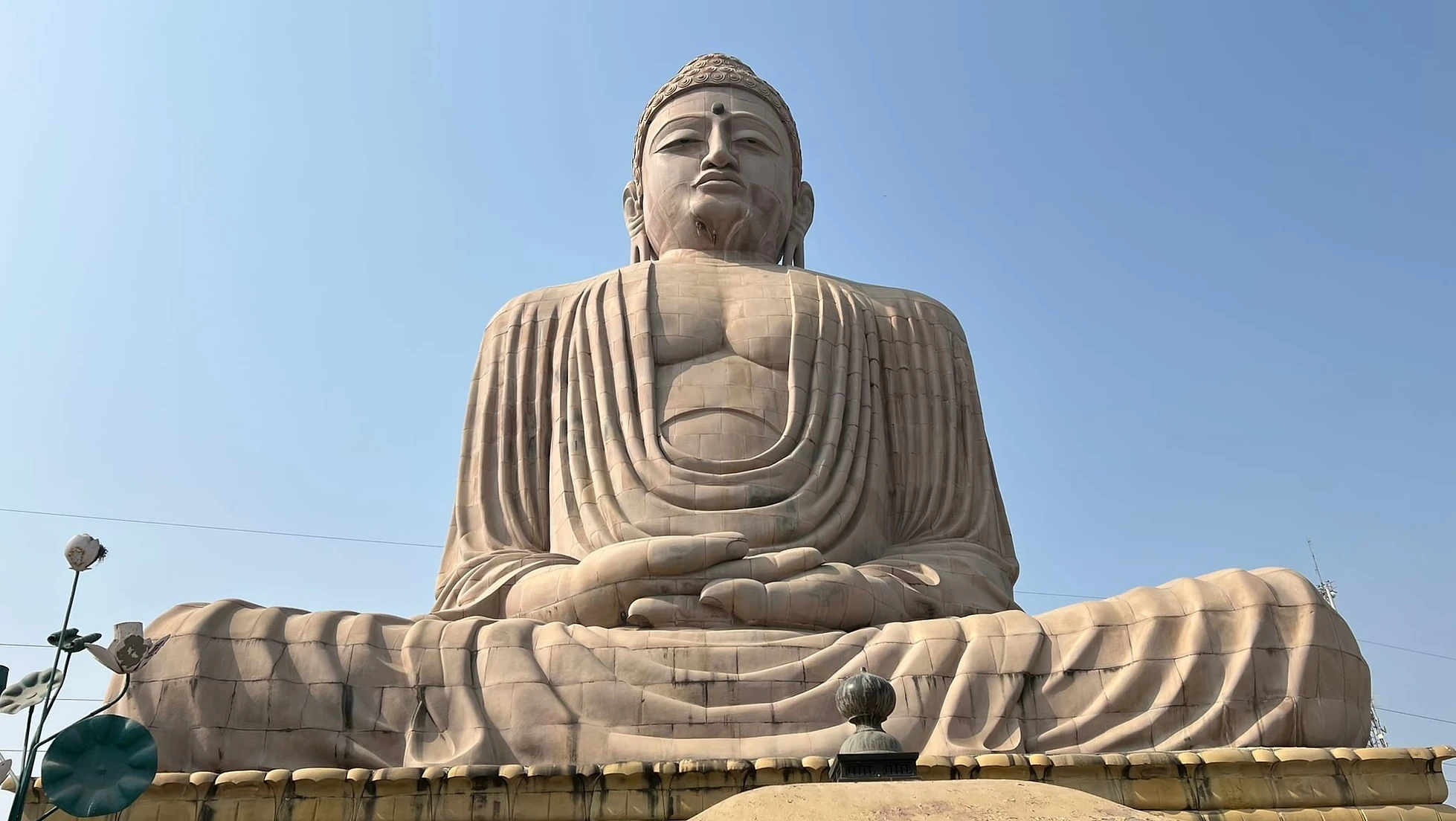Buddhist Philosophy
Tibetan Buddhist Philosophy
Timeless Teachings Upheld by the Pillars of Authenticity and an Unbroken Lineage

Tibetan Buddhist philosophy is an exceptionally rich tradition in which the Buddha’s teaching has been meticulously preserved and passed down through an unbroken lineage of teachers to the present day. Such great masters as Nagarjuna, Atisha, and Lama Tsongkhapa made the teaching accessible to all students through their enlightened commentaries. Their whole-hearted devotion and practice enabled them to demonstrate the true fruits of the Buddha’s teaching: the attainment of a perfectly enlightened, compassionate mind.
The program of studies and meditation offered by Lama Samten and the teachers of Paramita Centre are based entirely on the Buddha’s teaching and specifically on the Lamrim tradition (The Stages of the Path to Enlightenment). The subjects covered are the same as those offered at the monastic university of Ganden Jangste in South India. You are invited to browse through the various topics listed on this page. You may also want to consult Lama Samten‘s book The Essence of the Path to Enlightenment for a more in-depth description of the same topics.
The information on this page is a brief overview of some of the many facets of Buddhist philosophy but is in no way intended to be complete.
Is Buddhism a religion?
No. Although some of the rituals, chants, and mantras can seem like a religious activity in which we beseech an external guide, force, or creator god for favor, these rituals in fact are designed to help students and practitioners call to mind the teachings and trainings. In Buddhism, no “other” holds the keys to happiness, and there is no “other” whom we worship. Similarly, no “other” judges our actions and metes out reward and punishment. Instead, we rely on the teachings to find our way to happiness and abandon those things that lead to suffering and harm.
I am my own enemy, I am my own protector
Shakyamuni Buddha
Are all Buddhists the same?
Yes and no. There are certain beliefs that are core to being Buddhist (see the four seals, below), and all Buddhists hold them in common. At the same time, it is important to realize that Buddhism is impacted by the cultures in which it thrives. The manner in which Buddhism is taught and the recommended practices can differ depending on local culture, customs, and language, and on students’ individual needs. The key thing, however, is to ensure that the core of the teaching remains true to the unbroken lineage. The teachers of the Paramita Centers follow a specific lineage of Tibetan Buddhism – the Gelug tradition, which is the same lineage as taught by His Holiness the 14th Dalai Lama.
You can trust that what you hear from us is authentic to the core of Buddha Shakyamuni’s teaching, and true to our tradition, but you must check for yourself to see if it rings true and benefits you and others. As the Buddha taught,
Just as a goldsmith would test his gold by burning, cutting, and rubbing it, so you must examine my words and not accept them merely out of reverence for me.

Who can benefit from learning about Buddhism?
One of the ramifications of the fact that Buddhism is not a religion is that much of Buddhist philosophy – although not all of it – is compatible with any religious tradition. There is no need to “convert” to Buddhism, and no one here will ask you to. But for anyone of any belief system, there is much to be learned from Buddhist ideas about ethics, doing good in the world, and seeking to benefit all beings. There is also much to be learned from meditation and training the mind to be focused and calm. None of this is religion; instead, consider it sound advice on living a better and more beneficial life. Of course, if you are a Buddhist or wish to learn more about being one, more information is available.
Why Study Buddhism?
Lama Samten has often explained that happiness is the ultimate goal of life and that this is true regardless of one’s beliefs or absence of beliefs. The main impetus of our lives is always oriented toward being happy; all beings wish to increase happiness and reduce suffering. You can verify this for yourself with simple observations – no living thing willingly seeks out misery.
And yet somehow, there seems to be no end to suffering. Buddhist philosophy describes three kinds of suffering:
Lama Samten insists that every sentient being aspires to happiness and wants to avoid suffering. No one wants to suffer. This is a fundamental truth. About 2600 years ago, the Buddha found and subsequently taught a means for ending the never-ending cycle of suffering once and for all. That alone is a good reason to study Buddhist philosophy and the practices that will bring us “happiness without suffering.”
Finding happiness
How can this happiness be obtained? Happiness can be found by training the mind and applying inner discipline to our thoughts, feelings, sentiments, and emotions. In this way we can transform our attitudes, our concepts, and our way of being in the world. Learning how to ensure a happier life allows us to better understand how this search for happiness is very advantageous – as much for ourselves as for our family and society. The key to a happy and fulfilling life is found in our state of mind.
This is not to say that “changing our attitude” will magically resolve all external factors that are difficult to resolve and painful to experience. But we all know the person who, despite objectively difficult circumstances of illness, deprivation, or other problems, has inner peace; he or she is often an inspiration to be around. We also all know the person for whom the smallest problem creates great suffering, which he or she often inflicts on everyone around. Perhaps you recognize these tendencies in yourself. Changing our minds changes the way we experience life, even while we work hard to resolve the difficult external circumstances we or others experience.
Here, it is important to make a distinction between happiness and pleasure. The two are very often confused. The highest form of happiness to be attained is being completely free of all suffering. This is what we refer to as authentic and lasting happiness. Thus, real happiness refers to the heart and the mind, while that which depends on physical pleasure is unstable and unreliable. One day it is there, and the next, it is gone.
Lama Samten admits that he is greatly motivated to obtain happiness and insists on its importance. He suggests that we first observe and study the different aspects of happiness to assist us in our search for it. We must discover for ourselves just how our negative emotions and behaviors are destructive and, similarly, how positive acts and feelings are beneficial. Since certain behaviors and emotions are always harmful to the individual and the whole of society, we must be determined to abandon them.
The sources of happiness
All sentient beings share the same wish: to find happiness and avoid suffering. This need is the same for everyone, regardless of age, gender, race, or culture. In fact, the need is not limited to humans; animals and all species of sentient beings also seek to avoid suffering. In order to find this happiness, it is important that we recognize its real causes and conditions. What exactly are these conditions? Let us use the concept of friends and enemies as an example.
If we take the time to reflect on what constitutes a friend or an enemy, we will inevitably discover that all these people with whom we share our everyday existence can not be identified as friends or foes in themselves. They are called ‘friends’ or ‘enemies’ due to our perception of them as such. If a person is identified as a friend or an enemy in the true sense of the term, he/she would be that same friend or enemy for everyone. Of course, we know that this is not the case and that identifying someone as a friend or an enemy is an entirely subjective perception based on our own perception of them.
The same applies to our problems and various forms of suffering. They, too, are the result of our perceptions, mental afflictions, and our exaggerated sense of self-importance. Furthermore, if we also believe that our enemies are only those that we perceive externally and justify our seeking vengeance by resorting to anger, pride, and jealousy, we are actually overlooking the real cause of our suffering. If we choose to remain in this state, happiness becomes an impossibility.
If we take the time to reflect on the subject honestly, we will come to realize that just as a well-cultivated field is beneficial and profitable for everyone, so too are all sentient beings a source of goodness and benefit. Our material well-being, social networks, education, and even our qualities are all dependent either directly or indirectly on the presence of others. Where could we find similar advantages and goodness if no other sentient beings existed? Realizing that much of what we take for granted comes from others makes it that much easier for us to develop compassion, which is the root of the Path to Enlightenment. It is unfortunate that because of ignorance, so many of our actions often become sources of unhappiness, in spite of the fact that all we really want is happiness.
Happiness can only be the fruit of the positive actions carried out by our body, speech, and mind. Problems, on the other hand, can only be the result of the negative actions of the same body, speech, and mind. Thus, it is in such states of mind as anger, jealousy, and pride that all the causes of our problems and suffering are created. But by developing such qualities as love, compassion, humility, patience, and wisdom, we are creating the sources or causes of joy in ourselves and our world.
Training the mind toward happiness
Happiness and suffering arise mostly from our mental perceptions. Hence, we are dealing with inner mental states. If we can properly train our minds, we can even perceive suffering as a means of eliminating the effects of negative acts committed in the past.
Rather than reacting instinctively by becoming discouraged, sad, or angry and increasing our suffering, we can choose to cultivate joy and lessen the impact of potentially painful negative circumstances. Similarly, when good fortune comes our way, we can sincerely rejoice because this is a sure sign that we are reaping the benefits of our practice of kindness and Bodhichitta (mind of enlightenment), thereby giving our precious human life its true significance.
In Buddhist philosophy, we train the mind toward mental states that promote our well-being and the well-being of all life. Whether or not we are blessed with material wealth, family, and friends, we can always cultivate happiness by developing an attitude of generosity and gratitude. By developing these qualities, not only are we benefited, but we become a source of happiness for others as well.
Thus, whatever the circumstances may be, it is important that we make the best possible use of our capacities so that when we do finally reach the end of our lives, we do so in a state of joy and serenity. We must cultivate these positive feelings to leave this life with a mind that is at peace, having done all we can to leave the world a better place.
We train the mind in order to accomplish benefits for ourselves and all life. With this in mind, and until we attain Enlightenment, we can whole-heartedly wish that every sentient being finds lasting happiness, free of all suffering and its causes. This is why we study Buddhist philosophy and why we learn to practice meditation.
Introduction to the Lamrim (the path to enlightenment)
The teachings of the Buddha (the Dharma) is said to include 84,000 different teachings, as captured in over 100 volumes of direct teachings and many more volumes of commentaries on those texts. The Dharma, taken as a whole, is vast and can be very confusing to try to understand without a guide. Fortunately, a clear path through the teachings has been given in the Tibetan lamrim tradition.
The root text that incorporates the instructions for navigating the Dharma is found in The Lamp on the Path to Enlightenment, written by the great Indian scholar and practitioner Atisha Dipamkara Shrijnana (982-1054). In this text, Atisha extracted the essence of all 84,000 teachings of the Buddha and organized them into clear steps, known as the Lamrim. In what follows, when we refer to “the Dharma,” we specifically mean the lamrim teachings based on Atisha’s root text.
Embarking on the path
We are able to embark on the path to enlightenment at this time and place for two essential reasons: we have a precious human life, and we have met, or have the potential to meet, an authentic teacher.
The unique qualities of Buddhist lamrim teachings
It is said that this Dharma (the Lamrim) has four greatnesses, which we can compare to the steps involved in preparing for a trip: the first greatness is finding the best route to take, the second is actually visualizing the road in our mind, the third is arriving at our destination, and the fourth is the peace of mind experienced when the trip is over. In more detail the four greatnesses are:
The lamrim path is organized into three scopes
The small scope
The teachings shared with practitioners of the small scope encompass such subjects as impermanence, suffering, the inevitability of death, karma, and taking refuge.
Although ‘small’ might seem to suggest something of lesser importance, that is far from being true in this case. On the contrary, the small scope is the base, the first level of preparation for the entire Path of Enlightenment. It cannot be neglected or overlooked. What is accomplished at this level is absolutely necessary for developing the qualities and realizations in both the medium and great scopes.
Our overall objective is total Enlightenment, but much must be done before we can attain it. Thus, the primary aim of the small scope is to ‘set the stage,’ to ensure the best conditions for our next rebirth.
The medium scope
The teachings shared with practitioners of the medium scope focus on the Four Noble Truths, the Three Poisons, the Twelve Interdependent Links, Samsara, and the Path to liberation.
Once our motivation is well established through practice in the small scope, and we are able to persevere in working conscientiously toward creating the conditions conducive to higher rebirth, we can become ready to seek complete liberation from suffering. This liberation is called Nirvana, which is a state where there is no suffering and where we perceive reality as it is. Medium-scope studies and practice allow us to take a deeper look into the nature of suffering and its causes. As a result of this understanding, we can work more efficiently to abandon those aspects of ourselves that are counter-productive to the happiness we seek.
The great scope
Whereas a practitioner of the medium scope seeks personal liberation from all suffering, the teachings shared with practitioners of the great scope emphasize the importance of developing Bodhichitta (the mind of Enlightenment). Instead of seeking only our personal liberation, we see that all beings suffer, and we develop the motivation to liberate all sentient beings. We see that an infinite number of beings – including but not limited to friends, family, and neighbors – find themselves in difficult and painful circumstances, and we cannot remain indifferent to such suffering. The teachings shared with practitioners of the great scope train us in the methods to develop and realize the altruistic motivation to free all beings.
The practitioners of the great scope seek unceasingly to rid themselves of any obscuration that limits their capacity to assist all those who are still prisoners of Samasara and its suffering. Armed with an enlightened mind rooted in universal love and unlimited compassion for all sentient beings, we seek our ultimate goal: full Enlightenment and Buddhahood.
If You Want to Learn More
As we have said, it is not necessary to become a Buddhist in order to learn and benefit from the teachings. It is certainly not necessary to become a Buddhist to gain the benefits of learning meditation, and it isn’t necessary to become a Buddhist in order to become a better, more compassionate person. What follows is a very brief introduction to what it means to be a Buddhist for those who are interested.
What do Buddhists believe?
Refuge
To be a Buddhist, it isn’t necessary to participate in a particular ritual. It certainly is possible to take lay vows with a qualified master, but it isn’t the essential point. Being a Buddhist is characterized by taking refuge in what we call the three jewels: Buddha, Dharma, and Sangha. We come to believe that the Buddha taught a genuine way to attain happiness and end suffering once and for all. We believe that the path he taught – the Dharma – is the perfect set of instructions to follow in order to attain liberation. Finally, we believe that there are others who have followed the path, collectively known as the Sangha (assembly), and they provide us with evidence that enlightenment is attainable.
To take refuge isn’t to have blind faith. Taking refuge means that through study and practice, we have complete confidence that the 3 jewels are the path that leads to liberation. An analogy may help: when we are caught in a storm, we look for a sturdy shelter in which to take refuge. We look for a structure that will withstand the storm and keep us safe. In the context of a storm, that shelter is our refuge. As Buddhists, we see that we are caught in a storm of suffering, the endless cycle of samsara, and we take shelter in the Buddha, the Dharma, and the Sangha.

The four seals
Having taken refuge, there are 4 core beliefs in which all proponents of a Buddhist philosophical system have confidence. They are so important that we call them the seals. The meaning of the seals is profound and complex. In a very brief form, the four seals are:
- All compounded phenomena are impermanent
- All contaminated phenomena are in the nature of suffering
- All phenomena are without inherent self
- Nirvana is beyond extremes
These few words are just the barest start to following a rich path, for those who seek it. But perhaps in the end being “a Buddhist” is not so important. I remember hearing someone say that when he tries to explain being Buddhist, people tend not to understand why he would take such a path. But when he tries to be like a Buddha – full of compassion for others and working for their benefit – that is sometime people understand. Perhaps, he said, it’s better to be a Buddha than a Buddhist.
Resources
The words on this page, and the website as a whole, are dedicated to the benefit of all sentient beings. They are collected with the hope that others may find value in the original teachings, and that I have adequately conveyed the meanings as I have learned them. Any errors lie with the collator, Lobsang Tharchin, a devoted but flawed student, and not with the dharma or my teachers.
Om mani pémé houm!
(The Mantra of Compassion)
